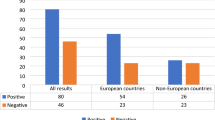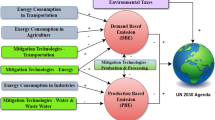Abstract
The stabilization of budget deficit and budget debt ratios by fiscal retrenchment in order to fulfill the Maastricht criteria for the EMU is of central focus in most EU countries. At the same time the national policy dimension of acute environmental problems such as global warming has receded in the public eye. The environmental dimension nonetheless remains urgent, and a re-evaluation of the prospects of CO2-policy is needed against the background of fiscal retrenchment required by supranational obligations. We shall do this for the small, open, Austrian economy by constructing a dynamic multi-cohort CGE model enabling us to assess quantitatively the lifetime welfare impacts on the cohorts affected by three different options for using CO2-permit revenues. The distribution of welfare costs of (Toronto-) CO2-policy across cohorts significantly differs with use. This is explained by income, inheritance and price effects.
Similar content being viewed by others
References
Allais, M. (1947), Economie et Interest. Paris: Imprimerie Nationale.
Armington, P. S. (1969), ‘A Theory of Demand for Products Distinguished by Place of Production'. International Monetary Fund Staff Papers 16, 159–178.
Auerbach, A. J. and L. J. Kotlikoff, (1987), Dynamic Fiscal Policy. Cambridge: Cambridge University Press.
Ballard, C. and J. Kim (1995), ‘An Assessment of the Effects of a Tax on Consumption, Using a Computational General Equilibrium Model with Overlapping Generations', 6th CGE Modeling Conference, Oct. 26–28, Waterloo.
Bergman, L. (1988), ‘Energy Policy Modeling: A Survey of General Equilibrium Approaches'. Journal of Policy Modeling 10, 377–399.
Bergman, L. (1991), ‘General Equilibrium Effects of Environmental Policy: A CGE-Modeling Approach'. Environmental and Resource Economics 1, 43–61.
Bergman, L. (1995), ‘Environment-Economy Interactions in a Computable General Equilibrium Model: A Case Study of Sweden', in Johanson, P.-O., B. Kriström and K.-G. Mäler, eds., Current Issues in Environmental Economics. Manchester: Manchester University Press.
BMwA (1990), Energiebericht 1990 der Österreichischen Bundesregierung. Wien.
Boyd, R., K. Krutilla and W. K. Viscusi (1995), ‘Energy Taxation as a Policy Instrument to Reduce CO2 Emissions: A Net Benefit Analysis'. Journal of Environmental Economics and Management 29, 1–24.
Breuss, F. and J. Tesche (1994), ‘A General Equilibrium Evaluation of Trade and Industrial Policy Changes in Austria and Hungary'. Weltwirtschaftliches Archiv — Review of World Economics 130, 534–552.
Breuss, F., A. Köppl, K. Kratena and W. Puwein, (1993), Die ökologischen Auswirkungen des Binnenmarktes auf Österreich. Wien: Studie des Österreichischen Instituts für Wirtschaftsforschung.
Brooke, A., D. Kendrick and A. Meeraus (1992), GAMS — A User's Guide, South San Francisco: The Scientific Press.
Bundesministerium für Finanzen (1993), Bundesvoranschlag 1994. Wien.
Burniaux, J.M., J. P. Martin, G. Nicoletti and J. Oliveira-Martins (1991), ‘GREEN — A Multi-Region Dynamic General Equilibrium Model for Quantifying the Costs of Curbing CO2 Emissions: A Technical Manual'. OECD Economics and Statistics Working Papers 89. Paris: OECD.
Conrad, K. and J. Wang, (1993), ‘Quantitative Environmental Policy: The Economic Impact of CO2 Tax in Germany (West)'. Jahrbücher für Nationalökonomie und Statistik 212, 309–324.
Diamond, P. (1965), ‘National Debt in a Neoclassical Growth Model'. American Economic Review 55, 1126–1135.
Drud, A. S. (1992), GAMS/CONOPT, Appendix to the GAMS User's Guide, mimeo, ARKI Consulting, Bagsvaerd.
Glomröd, S., H. Vennemo and T. Johnsen (1992), ‘Stabilization of Emissions of CO2: A Computable General Equilibrium Assessment'. Scandinavian Journal of Economics 94, 53–69.
Hazilla, M. and R. J. Kopp (1990), ‘Social Cost of Environmental Quality Regulations: A General Equilibrium Analysis'. Journal of Political Economy 98, 853–873.
Hicks, J. R. (19391, 19462), Value and Capital. Oxford: Oxford University Press.
IPCC (1996), Second Assessment Report. Toronto: Intergovernmental Panel on Climate Change.
Johannsen (1960), A Multi-sectoral Study of Economic Growth. Amsterdam: North-Holland.
Johansson, P.-O. (1993), Cost-Benefit Analysis of Environmental Change. Cambridge: Cambridge University Press.
Jorgensen, D. W. and P. J. Wilcoxen (1990), ‘Intertemporal General Equilibrium Modeling of U.S. Environmental Regulation'. Journal of Policy Modeling 12, 715–744.
Keuschnigg, C. (1991), ‘Internationale und intertemporale Aspekte der Kapitaleinkommensbesteuerung', in Schriften des Vereins für Sozialpolitik Neue Folge, Band 210, 245–264.
Keynes, J. M. (1936), The General Theory of Employment, Interest and Money. London: Macmillan.
Köppl, A. (1993), ‘Der Zusammenhang zwischen Wirtschaftswachstum und Umwelt: Simulierte ökonomische Effekte von umweltentlastenden Strategien mit nationalen und globalen Umweltmodellen — Ein Überblick', in F. Breuss, A. Köppl, K. Kratena and W. Puwein, eds., Die ökologischen Auswirkungen des Binnenmarktes auf Österreich. Wien: Studie des Österreichischen Instituts für Wirtschaftsforschung, pp. 11–81.
Lager, C. (1993), Ein dynamisches Input-Output-Modell zur Beurteilung fiskalpolitischer Maβnahmen. Unpubl. Dissertation, Universität Graz, Graz.
Laitner, J. (1990), ‘Tax Changes and Phase Diagrams for an Overlapping Generations Model'. Journal of Political Economy 98, 193–220.
Lindbeck, A. and J. W. Weibull (1988), ‘Intergenerational Aspects of Public Transfers, Borrowing and Debt'. Scandinavian Journal of Economics 88, 239–267.
Neusser, K. (1993), ‘Savings, Social Security and Bequests in an OLG Model. A Simulation Exercise for Austria'. Journal of Economics, Suppl. 7, 133–155.
Nicoletti, G. (1990), Green Project — Survey of Interfactor and Interenergy Elasticities. Paris: OECD, mimeo.
ÖSTAT (1976), ‘Energieausstoß und-einsatz der Österreichischen Volkswirtschaft im Jahre 1974'. Statistische Nachrichten 31, 499–506.
ÖSTAT (1992), ‘Energieaufbringung und-verwendung in der Österreichischen Volkswirtschaft im Jahr 1989 — Endgültige Energiebilanz 1989'. Statistische Nachrichten 47, 490–506.
ÖSTAT (1993), Statistische Übersichten. Monthly supplement to Statistische Nachrichten.
Postsparkasse (1991), Bericht der Österreichischen Postsparkasse über die Finanzschuld des Bundes 1990. Wien.
Samuelson. P. A. (1958), ‘An Exact Consumption Loan Model of Interest with or Without the Social Contrivance of Money'. Journal of Political Economy 66, 467–482.
Summers, L. H. (1981), ‘Capital Taxation and Accumulation in a Life-Cycle Growth Model'. American Economic Review 71, 533–544.
Stephan, G., R. van Nieuwkoop and T. Wiedmer (1992), ‘Social Incidence and Economic Costs of Carbon Limits'. Environmental and Resource Economics 2, 569–591.
Steininger, K. W. (1995), Trade and Environment. The Regulatory Controversy and a Theoretical and Empirical Assessment of Unilateral Environmental Action. Heidelberg: Physica.
UBA (1995:1,3), UBA-INFO 1 and 3–95. Monatsinformation des Umweltbundesamtes. Wien: Umweltbundesamt.
Whalley, J. and A. Mansur (1984), ‘Numerical Specifications of Applied General Equilibrium Models: Estimation, Calibration and Data', in H. E. Scarf and J. B. Shoven, eds., Applied General Equilibrium Analysis. Cambridge: Cambridge University Press.
Author information
Authors and Affiliations
Rights and permissions
About this article
Cite this article
Farmer, K., Steininger, K. Reducing CO2-Emissions Under Fiscal Retrenchment: A Multi-Cohort CGE-Model for Austria. Environmental and Resource Economics 13, 309–340 (1999). https://doi.org/10.1023/A:1008243611666
Issue Date:
DOI: https://doi.org/10.1023/A:1008243611666




